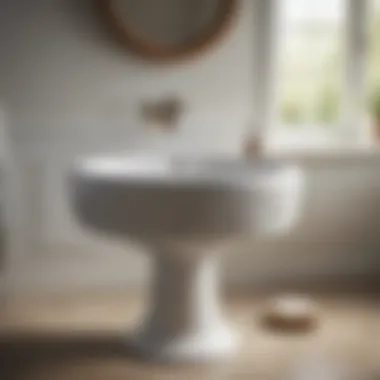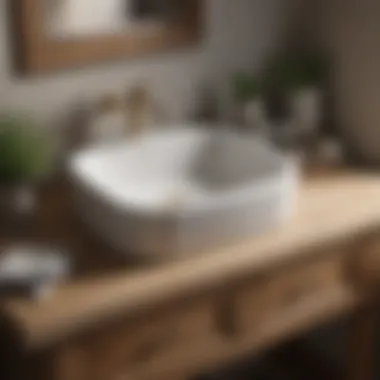Exploring the Charm of Farmhouse Pedestal Sinks


Intro
The farmhouse pedestal sink combines functionality with an attractive, rustic aesthetic, offering an interesting choice for modern bathrooms. Its unique charm lies not only in its design but also in its practical benefits. In this guide, we will help homeowners understand how to incorporate this sink style effectively into their bathrooms, detailing everything from the necessary materials to detailed installation processes. We encourage you to embrace this wonderful element of bathroom design and see how it enhances the space.
Materials:
Before diving into the installation process, it is crucial to gather all the required materials. Creating a list will save time and ensure you have everything needed for a successful project. Here are the essential materials for installing a typical farmhouse pedestal sink:
- Farmhouse pedestal sink (measure size appropriate to your bathroom space, typically around 30 to 36 inches in height)
- Faucet and mounting hardware (size depending on sink)
- Water supply lines (hot and cold, usually 3/8-inch diameter)
- Double basin drain assembly (make sure it fits the sink)
- Silicone caulk (white or clear, for sealing)
- Shims (if leveling is needed)
- Plumber’s putty
- Towels
- Electrical outlet cover (if near water sources)
Tools Needed:
Gather the necessary tools to make installation easier:
- Adjustable wrench
- Screwdriver set (flathead and Phillips)
- Level
- Tape measure
- Pipe wrench (optional)
- Drill with bits
- Hacksaw (if pipe adjustments needed)
- Pliers
- Utility knife
DIY Steps:
With all materials in place, follow these detailed instructions for a successful installation of your farmhouse pedestal sink.
Step 1: Prepare the Site
- Start by turning off the water supply to your existing sink. This is essential to avoid any unwanted flooding.
- Remove any old fixtures and take out the old sink, making sure to disconnect relevant plumbing.
- Clean the area where your new sink will be installed to create a smooth surface.
Step 2: Position the Sink
- If your new sink needs assembly, do it beforehand.
- Once assembled, position the pedestal sink in its desired place and use a level to ensure it sits evenly on the floor. Adjust height with shims if necessary.
Step 3: Install the Faucet
- Locate the mounting holes on the sink deck. Place the faucet’s base plate through the holes and secure it below using the provided hardware.
- Connect the hot and cold supply lines to your faucet.
Step 4: Connect Drain Assembly
- Take your drain assembly and insert it into the sink's outlet using plumber’s putty for proper sealing.
- Connect the drain pipes, checking with a pipe wrench for any needed adjustments.
Step 5: Final Checks
- Double check all connections before turning the water back on. Look for any areas needing extra sealing with silicone caulk.
- After confirming distance and adjustment capabilities, now turn on the water supply slowly to test each connection.
Tip: Run water through the taps for several minutes to confirm any leaks, responding promptly if found. Any minor adjustments can save from future issues.
Technical Aspects:
As with any DIY project, the technical aspects of installation must not be overlooked. Timing and technique can significantly influence the outcome. Expect the entire installation to take between two and four hours, set aside ample time to focus.
Essential techniques for maximizing your installation:
- Use a level constantly throughout your installation to make certain every component is straight and aligned.
- When fastening plumbing connections, ensure a firm but careful grip—the risk of damaging pipes can disrupt future functionality.
- The final caulking should finish every exposed edge for a polished look.
DIY Project Process:
After confirming an organized installation plan, head into the specific process sequence.
Sequential Steps:
- Choose your appropriate position carefully based on both aesthetic display and functionality.
- When placing supply and drainage components, refer closely to set locations laid out by manufacturers' manuals.
- Conduct your first round of tests post-installation to tighten any loose adjustments; this promotes long-lasting hold and performance.
- Paint/Add finishing touches to您的新水槽, making certain your bathroom maintains compliant aesthetic beauty.
Troubleshooting Tips:
Every DIY project may encounter mistakes; remain prepared and flexible. Here are common issues with solutions:
- Leak at the Faucet Base: Tighten smartly, ensuring alignment is intact.
- Drain Backing Up: A build-up might occur; ensure drains are clear of obstructances.
- Sink Wobbling: Additional shims might help distribute balance more clear on surfaces.
By addressing challenges directly, you can effortlessly maintain satisfaction with your beautiful farmhouse pedestal sink.
Intro to Farmhouse Pedestal Sinks
Farmhouse pedestal sinks have emerged as notable fixtures in contemporary bathroom design. Their increasing popularity stems from a combination of functionality, aesthetic appeal, and a nostalgic, rustic charm. This specific type of sink is not only about utility; it encapsulates a sense of warmth and familiarity, allowing homeowners to create a welcoming atmosphere in their bathrooms. Understanding the nuances of farmhouse pedestal sinks is essential for any individual looking to elevate their bathroom décor.
Defining the Farmhouse Aesthetic
The farmhouse aesthetic signifies simplicity and practicality, intertwining natural elements with vintage accents. This aesthetic combines comfort and elegance, maintaining a balance that speaks to both modern sensibilities and rustic nostalgia. The farmhouse style generally involves a mix of materials and textures, aiming for a relaxed yet sophisticated look. Farmhouse pedestal sinks frequently highlight smooth curves and soft lines, creating a gentle focal point in the bathroom.


Some key characteristics of farmhouse sinks include:
- Classical Design: Features that resemble those historically found in older homes, promoting a timeless quality.
- Natural Materials: Regular use of stone, ceramic, or porcelain, which supports sustainability.
- Warm Colors: Subdued and earthen tones that evoke a tranquil space and enhance other features in the bathroom.
These attributes make them suitable in various decor styles, while informing choices in matching elements such as cabinetry or tile work.
Historical Context of Pedestal Sinks
Pedestal sinks have a rich history that dates back to the early 19th century, becoming a hallmark in bathrooms during that era. Initially, these sinks served a functional purpose by elevating plumbing and providing architects and homeowners with more floor space.
As indoor plumbing standards improved, pedestal sinks further evolved into not just functional items, but also stylish design statements. Often found in arts and crafts movement designs, they signified a preference for detailed craftsmanship. The rise of the suburban home in the mid-20th century solidified their place in American bathrooms, often featured in homes meant for families.
Today, farmhouse pedestal sinks draw from this historical context, capturing both the beauty and utility that earlier models represented. By providing classic features in conjunction with modern functionalities, these sinks serve as a link between past and present. They epitomize how a single design element could inform the entire aesthetic of a bathroom, contributing both history and charm.
Functional Advantages of Farmhouse Pedestal Sinks
The farmhouse pedestal sink serves not only as a vessel for basic hygiene but also accentuates the functional aspects of a bathroom. Its design returns many benefits. These include enhanced space utilization, effortless maintenance, and improved accessibility, making it a popular choice for thoughtful homeowners seeking both style and practicality in their spaces.
Space Efficiency in Small Bathrooms
In smaller bathrooms, every inch counts. The farmhouse pedestal sink is designed with a slender profile that omits extensive cabinetry, offering relief from cramped conditions. This freestanding style takes up less floor space while still providing adequate bowl size for daily use.
Effective use of vertical space should not be overlooked. The raised design not only allows for easy under-sink cleaning but also gives an illusion of more area. Color and finish choices further help small areas feel larger or more spacious.
Furthermore, a farmhouse pedestal sink makes even the tiniest bathroom feel welcoming and functional. Guests may appreciate this thoughtful design choice, acknowledging that even compact areas can have character. Since it stands unsupported, one can also showcase added decor elements like wall shelving nearby, optimizing both storage and presentation in the bathroom.
Accessibility Considerations
A robust consideration in bathroom design is accessibility for individuals of all ages and abilities. The height and construction of farmhouse pedestal sinks ensure direct usability for most people. Their design typically accommodates wheelchair users and others with disabilities, maximizing comfort.
Sinks that stand on their own allow for easier access, eliminating lower cabinetry that can obstruct many users. The open space underneath provides room for wheelchair footrests, which enhances independent movement when transferring from a wheelchair.
In addition to the design aspects, it's crucial to comply with accessibility standards for bathrooms. This not only encourages inclusivity but also enhances utility for users.
Choosing the right pedestal sink can reflect both aesthetics and functionality, ensuring the bathroom is welcoming for everyone.
Overall, when exploring the benefits of farmhouse pedestal sinks, both space efficiency and accessibility form the backbone of its appeal, making it a strategic decision for many home designs.
Aesthetic Appeal of Farmhouse Pedestal Sinks
The aesthetic appeal of farmhouse pedestal sinks holds considerable importance in contemporary bathroom design. These sinks serve as distinct focal points, effortlessly blending functionality and beauty. Their design balances modern sensibilities while retaining a rustic charm. Thus, they offer a versatile option that resonates with different interior styles, making them more than just practical fixtures.
Matching with Modern Bathroom Decor
Farmhouse pedestal sinks articulate a unique personality that works harmoniously with modern decor. In recent years, the trend of merging rustic and modern elements has gained popularity. Adoption of farmhouse pedestal sinks adds warmth and character, standing in contrast to typically sleek bathroom finishes.
- Utilizing natural materials in modern bathrooms complements the organic feel of farmhouse designs.
- Fixtures such as brushed nickel or matte black metal can enhance the overall style while maintaining a contemporary edge.
- Incorporate some minimal yet striking accessories such as wooden mirrors. This integrates rustic elements with current trends, ensuring balance.
Above all, colors and textures play a crucial role in this equilibrium. Using a farmhouse sink contrasts beautifully with brighter colors and modern finishes, creating a unified visual narrative in careful design balance.
Color and Finish Options
Color and finish options greatly affect the aesthetic appeal of farmhouse pedestal sinks. Homeowners have a wealth of choices ranging from soft whites to deep, rich hues, allowing personalization.
- Classic White: This timeless finish creates freshness and a level of refinement. Seen more traditionally, adding a white sink to modern designs poses an engaging mixture.
- Pastel Shades: Pairing softer colors like light blue or pale green adds a delicate, quaint touch, emphasizing the farmhouse aesthetic.
- Bold Colors: While less common, using darker shades lends a bold approach and projects individual style.
Moreover, finishes vary significantly:
- Glossy Finishes: These provide a more polished aesthetic that reflects light well, enhancing space illustration.
- Matte Finishes: They offer a softer touch that aligns with farmhouse decor, inviting warmth to the bathroom environment.
Material Choices for Farmhouse Pedestal Sinks
Material selection is a fundamental aspect when considering farmhouse pedestal sinks, as it directly affects both aesthetics and functionality. Material choices influence durability, maintenance, appearance, and even the overall ambiance of the bathroom. For homeowners and designers, understanding the characteristics of different materials is essential to ensure the sink not only looks appealing but also fits within the practical constraints of the space and lifestyle.
Ceramic vs.
Porcelain
Ceramic and porcelain are both popular options for farmhouse pedestal sinks. Ceramic sinks are typically made from red or white clay. They are coated with a glossy glaze that ends to be non porous. This helps prevents staining, and makes cleaning easier. Ceramic is durable, but can chip under heavy impact.
Porcelain, on the other hand, is a type of ceramic but is made with more refined materials and is fired at higher temperatures. This results in a denser and more compact material that's less porous. Porcelain sinks offer a sophisticated look and are structurally stronger compared to common ceramic sinks. Additionally, they are more resistant to scratching and staining.
- Advantages of Ceramic: Affordable, lightweight, and functional. Well-suited for a variety of designs.
- Advantages of Porcelain: Greater durability, aesthetic appeal, and ease of maintenance. Adds a refined touch.


Choosing between ceramic and porcelain may depend on individual preferences regarding cost, daily usage, and style aspirations.
Stone Options: Granite and Marble
Granite and marble are luxurious choices for farmhouse pedestal sinks that significantly elevate a bathroom’s look. Granite is a hard stone, known for its strength and resistance to scratches and stains. Each granite sink is unique due to the natural variation in colors and patterns created during its formation. This individuality appeals to many homeowners seeking to incorporate distinct elements into their spaces.
Marble, while equally appealing, is different in terms of its softness and porous nature. It provides a classic aesthetic with elegant veins and shades that vary from piece to piece. However, marble requires more care because it can show stains and scratches over time. Frequent sealing is necessary to maintain its look and longevity.
- Strengths of Granite: Durable, resists heat and scratches, large variety available.
- Strengths of Marble: Timeless elegance, stunning variations, excellent for luxury designs.
By considering how often the sink will be used and the overall required maintenance levels, homeowners can make informed decisions on stone selections for their bathrooms.
Metallic Finishes: Stainless Steel and Copper
When it comes to choosing a metallic finish for farmhouse pedestal sinks, stainless steel and copper are two popular yet fundamentally different options. Stainless steel is a modern choice that offers both sleek design and functionality. It is resistant to stains, corrosion, and heat, which contributes to its widespread use in numerous settings.
Copper, perhaps more traditionally rustic, presents vibrant and changing patinas over time. While beautiful, copper requires certain maintenance to protect against tarnishing. Over the years, this may create a range of colors that appeal to those wanting a unique aesthetic. Its antimicrobial properties also make it a hygienic option.
- Benefits of Stainless Steel: Contemporary look, high durability, low maintenance.
- Benefits of Copper: Classic charm, evolving appearance, natural antibacterial properties.
To enhance bathroom design, it’s wise to consider what finishes will best complement existing decor and how much maintenance one is willing to perform. Appropriate metallic finishes can become striking focal points in bathroom design.
A well-chosen material not only impacts the aesthetic, but it also determines how a sink performs over time. Consider both present needs and future maintenance before deciding.
The careful evaluation of available materials can lead to choices that enhance functionality and style in any bathroom, especially when considering farmhouse pedestal sinks.
Installation Considerations
Installation of a farmhouse pedestal sink involves careful planning and consideration. Understanding the technical details surrounding this process can make a substantial difference in both performance and visual appeal. Mainly, it combines elements of plumbing and ergonomics for user satisfaction. Therefore, these factors deserve thorough examination.
Plumbing Requirements
Proper plumbing setup is the backbone of any successful sink installation. Farmhouse pedestal sinks generally require standard drainage and water supply lines. However, due to their unique design, there might be specific adaptations you need to consider.
Key points regarding plumbing include:
- Drainage Issues: Ensure that the drain line aligns properly with the sink’s plumbing outlet to prevent leaks.
- Water Supply Details: You must have hot and cold water lines running from the wall, unless using a comprehensive plumping system.
- Wall Mounted Options: Some farmhouse sinks have plumbing fixtures attached to the wall above the pedestal, giving a modern edge while hiding unsightly pipes.
- Integration with Existing Systems: It is essential to verify that your current plumbing can handle the necessary modifications. Upgrade work may be required for compliance and functionality.
Getting these plumbing details right protects from future maintenance inconveniences. Insufficient knowledge or preparation here can result in costly repairs or dissatisfaction with your new sink.
Height Considerations for User Comfort
The height at which a sink is installed directly affects ease of use. For farmhouse pedestal sinks, the most common installation height is between 32 to 36 inches from the floor. It might vary depending on the user's stature and overall bathroom design. Some considerations to keep in mind include:
- Accessibility for All Users: If multiple individuals use the bathroom, finding a sink height that accommodates everyone is essential. Too high might leave shorter users uncomfortable.
- Standard User Heights: A standard height of 36 inches works for average adult users, but adaptability can lead to a better overall experience.
- Added Features: Some sinks come with adjustable pedestals or installations that allow for more flexibility in height. This feature is notable if you have unique design considerations in mind.
“Calibration of sink height enhances not just agility in operation but contributes significantly to overall bathroom ergonomics.”
Incorporating these factors while planning the installation phases will underpin a successful and pleasurable experience leading to lasting satisfaction with your farmhouse pedestal sink.
Maintenance and Care
Proper maintenance and care of a farmhouse pedestal sink is crucial for its longevity and sustained aesthetic appeal. Homeowners who adopt this sink styleable to enhance their bathroom design must also understand the best practices to maintain it over time. Practical care not only preserves the visual integrity of these sinks but also ensures hygiene and functionality. This detailed guide will provide insight into effective cleaning methods and preventative measures against common sources of damage.
Cleaning Materials and Techniques
Keeping a farmhouse pedestal sink clean requires the right approach and products. Avoiding abrasive cleaners will prevent scratches, which can mar the surface. Instead, consider using soft cloths or sponges along with mild detergents or soap. Here are some recommended practices:
- Daily Wipe-Down: After use, a quick wipe with a soft cloth can prevent soap scum build-up.
- Weekly Deep Clean: At least once a week, employ a solution of warm water and a few drops of gentle dish soap. Dip the cloth or sponge in the mixture, wring it out, then clean the sink’s surface.
- Disinfecting: Occasionally, to help reduce bacteria, a diluted vinegar solution or a customized cleaner fits well. Apply and let sit for a few minutes, then rinse thoroughly.
- Avoid Chemicals: Products like bleach or strong acids can harm the finish of sinks, so it's wise to steer clear of them. Opt for what is designed primarily for your sink material.
Preventing Damage and Stains
Preventing damage is an essential part of keeping your farmhouse pedestal sink in optimal condition. Certain actions and awareness of everyday things can greatly help. Here are some considerations:
- Water Spots: Hard water can lead to mineral deposits. To avoid this, wipe your sink after each use, particularly if water is left standing.
- Lemon Juice and Vinegar: Both have natural bleaching properties that can cause fading. Ensure these do not remain in contact with your sink for any prolonged duration.
- Heavy Items: Avoid placing heavy items in or on your sink; excessive weight can lead to cracks or weak points.
- Heat Protection: Hot pans or untreated materials can be detrimental to the sink's surface. Use trivets or coasters to eliminate direct heat.
Incorporating these practices will significantly extend the life and beauty of your farmhouse pedestal sink and ultimately enhance your overall bathroom experience. Proper maintenance reflects a commitment to your space’s well-being, ensuring you enjoy both functionality and design for years to come.
Ultimately, a well-kept sink not only enhances utility but also adds value to the entire bathroom aesthetic.
Popular Trends in Farmhouse Sink Styles
The farmhouse pedestal sink has seen a resurgence in popular bathroom designs. As homeowners aim to integrate functionality with aesthetics, understanding current trends becomes essential. This is more than a aesthetic choice; it has implications for the overall atmosphere of a bathroom. Including a farmhouse sink can blend rustic charm with modern conveniences.


Design Trends
In 2023, specific design trends have emerged that bring the farmhouse pedestal sink to the forefront of bathroom aesthetics. One noticeable trend is the use of warm, muted tones. Colors such as soft beiges, warm grays, and muted greens provide a calming atmosphere, complementing the rustic quality of the sink. Moreover, there is emphasis on marrying this style with natural materials. For example, wooden shelves and stone accents work wonderfully alongside the sleek, often white, ceramic surface of the sink.
Another trend is sustainability. Homeowners increasingly prefer sinks made from eco-friendly materials, which aligns well with minimalist and farmhouse aesthetics. Reclaimed wood and vintage fixtures have become favorites, promoting an eco-conscious lifestyle without compromising on style. Incorporating elements like repurposed wood cabinets or bamboo accessories can contribute to this effect.
Key Features in 2023:
- Neutral Color Palettes: Soft hues evoke a calming space.
- Sustainable Materials: Emphasis on eco-friendly choices.
- Natural Light: Maximizing light complements the design and space functionality.
Incorporating Rustic Elements
The attraction of rustic elements cannot be overlooked. In bathroom design, these aspects can accentuate the charm of the farmhouse sink. Using reclaimed wood or barn doors adds personality and contrasts beautifully with the sink’s clean lines. When selecting fixtures, selecting oil-rubbed bronze or brushed nickel can enhance the overall rustic ambiance, marrying both traditional and contemporary feelings.
Textures also play a crucial role here. Rough-hewn wooden elements or natural stone taps bring tangible complexity to the overall look. Adding textiles, such as a vintage rug or linen towels, can soften hard edges and introduce warmth.
Additionally, decorative elements should not be forgooten. Antique mirrors or vintage ceramics can often be effective in enhancing the journey from modern to rustic while remaining cohesive with the farmhouse style.
“An exceptional farmhouse type bathroom design brings together both vintage styles with present needs, creating a harmonious atmosphere.”
Some practical ways to incorporate rustic elements include:
- Choose natural wood cabinetry: It will resonate well with the sink’s designs.
- Opt for vintage towel racks: They add unexpected detail.
- Combine textiles: With rustic visual texture.
These choices facilitate a conversation between elements of the past and the present, creating a space that is inviting and enduring. By integrating these trends, homeowners can transform their bathrooms into appealing, functional spaces that highlight the uniqueness of the rustic and the contemporary.
Comparative Analysis with Other Sink Styles
A comparative analysis with other sink styles plays a crucial role in understanding the unique attributes of farmhouse pedestal sinks. This section not only elucidates the differences but also showcases how these differences can impact bathroom aesthetics and functionality. By analyzing how farmhouse sinks stand up against traditional and modern sink designs, homeowners can make informed choices based on their personal preference, design goals, and lifestyle needs.
Farmhouse vs.
Traditional Sinks
Farmhouse sinks are distinct from traditional sinks in several ways. While traditional sinks tend to be built into cabinetry, farmhouse sinks usually extend in front of the cabinetry, thus creating a more substantial visual presence. This outward projection is not merely decorative; it signals a robust, hands-on approach to design that often reflects a rustic charm.
Several important considerations emerge from this comparison:
- Material: Traditional sinks typically use stainless steel or porcelain glazed ceramic. In contrast, farmhouse sinks often incorporate materials like cast iron, which lends a more rustic appeal and resilience.
- Style Integration: Though both styles can complement various designs, farmhouse sinks introduce a vintage touch while traditional sinks align with classic functionalities.
- Installation Process: Installing a farmhouse sink may require adjustments to countertops and cabinetry. This contrasts with traditional sinks that often fit seamlessly into existing cabinets, making the installation smoother for some homeowners.
The choice between these sink styles often aligns with the overall bathroom design and the desired focal points of the space. Farmhouse sinks facilitate a focus on the sink area itself, elevating it beyond a mere functional appliance.
"Choosing the right sink reflects not just utility but the personality and aesthetic values of the homeowner."
Farmhouse vs.
Modern Sinks
Modern sinks typically prioritize sleekness, minimalism, and function over form. They often incorporate advanced materials and sleek lines, appealing to those who value a high-tech approach in their bathrooms. When juxtaposing modern sinks with farmhouse sinks, impressive contrasts are evident:
- Form vs. Function: While modern sinks aim for a streamlined look, farmhouse sinks deliver visual weight and reassurance of functionality.
- Design Flexibility: Modern sinks can adapt to various styles but may struggle to evoke character. In contrast, farmhouse pedestals introduce elements of history and warmth, resonating with many homeowners' nostalgia.
- Accessibility and Space: Modern designs often favor built-in technology, whereas farmhouse sinks prioritize simplicity. This might be relevant for users who are looking for straightforward, less complicated usage.
Overall, understanding the differences highlights not only taste choices but also practical implications for maintenance, installation, and eventual usability. Each sink has its unique advantages, fitting different needs and preferences. Homeowners should evaluate their requirements against each sink type's features and aesthetic contributions, ensuring a custom fit for their bathroom design journey.
Ending: The Role of Farmhouse Pedestal Sinks in Bathroom Design
Farmhouse pedestal sinks serve as notable fixtures that can unify traditional and modern elements in bathroom design. Their presence adds depth and character while fulfilling practical requirements. This conclusion emphasizes the aspect of individuality they provide as both a functional object and an aesthetic focal point.
Reflecting Personal Style
Choosing a farmhouse pedestal sink often reflects the homeowner's personal style. The divergent styles in the market allow homeowners to express their tastes distinctly. For instance, the sink design can align with rustic themes or harmonize with contemporary designs. This plurality appeals to those who appreciate unique elements in their spaces.
Homeowners may consider various styles and color finishes such as matte black, classic white or earthy tones. Whether looking to follow trends or create a timeless look, the farmhouse sink offers ample opportunities for customization.
- Elements of personal style can manifest through:
- Design of the sink (traditional, modern or rustic)
- Choice of materials (porcelain, ceramic, or even copper)
- Integration of decorative elements around the sink area, such as cabinetry or fixtures
Ultimately, the gradual integration of farmhouse elements allows individuals to articulate their unique vision in a highly personal environment.
Enduring Popularity and Timelessness
Farmhouse pedestal sinks have proven their staying power in bathroom design trends. Their durability and functionality contribute to their timelessness. As trends evolve, these sinks maintain a classic appeal.
Many residential designs incorporate classic elements, reflecting a desire for enduring aesthetics. Even with newer styles emerging, the farmhouse sink remains sought after for its nostalgia and robust form.
- Reasons for the sink’s enduring popularity include:
- Versatility in design fits different decors
- Compelling advantages that cater to practicality
- Ability to endure advancements in design while maintaining core appeal
This blend of utility and style keeps the farmhouse pedestal sink relevant, proving it unnecessary to seasonally update a classic element that continues to captivate homeowners. Its adaptation ensures that it remains a choice worth considering by advocates of both old-world and modern elegance.







